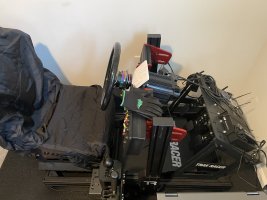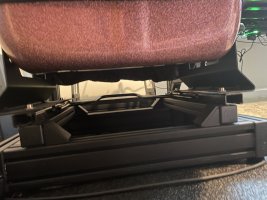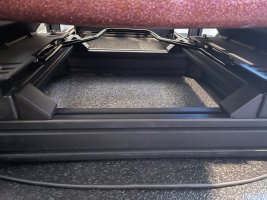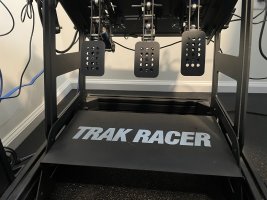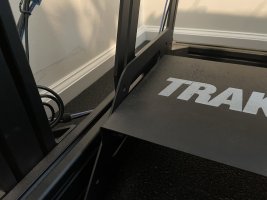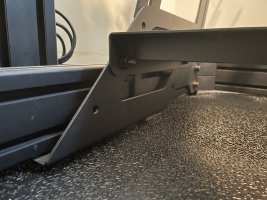You very much raise a current problem...
Their are many different ways and things to do or apply regards tactile immersion.
That is why it is easy to get confused with it.
Previous or past ways and hardware that has been widely adopted and very popular are no longer in 2024, now perhaps the best option. You have good rig here with inverted pedals and ideal seat, to apply what I propose would be rather simple.
I have some interesting ideas for you but I do not know what level of budget or future vision you plan to have on this tactile journey?
Excellent Timing?
In general this thread you have created, could be an excellent example for someone seeking help, to then share step by step their progress and giving your opinions on. With someone new to tactile or uncertain what to do, I am sure their still are many others in a similar situation to yourself and such a thread could be ideal for others to follow. I have a solution for you to consider that is probably the newest method...
Using the most recent and improved hardware. Enabling, even budget users an approach with supplied effects made specifically for that hardware. With simple goals, in achieving a better level of tactile immersion, in the simplest and most cost effective way.
It's upto you, what you decide to do or which approach you wish to take, no worries but I would be interested to see you try what I am offering and share your views here.
Either way, below I cover some points that may be of some help to you.
Stereo Effects:
For stereo to work best, the effects themselves need to be well configured to help with the stereo sensations. Simhub has multiple stereo effects we can better apply with some learned skills and methods. Yet you will not find, many people that have been adapting stereo sensations to both the pedals and seat. Doing so, that achieves good success or making those effects in a way they combine/support each other.
Okay, so their are various reasons for this and not just one, that I can explain if you want, however....
This is something I have been doing a lot of work/testing on, regards making tactile effects that better implement stereo positional sensations in both the pedals and seat. If you are interested in chatting more openly here about the prospects or what the potential is, then certainly go ahead and fire what questions you want.
Certain stereo effects are not always operating in a way that they are (on/off) active on one side with no activity on the other. This can vary and both sides may get responses but not identical. For our brains or bodies to identify these properly we want to feel these individual responses on the appropriate body sides.
Stereo Issues:
Many rigs will place units on corners to represent wheels and it is not really possible for the L/R operations from the tactile to maintain those individual responses from the effects. The simple reason for this is that the tactile vibrations freely flows over the rig/frame and via any connecting component. So basically on many peoples installations they are not controlling/limiting where the specific L/R vibrations can go or will be felt by the user.
No Control:
What generally happens on rigs using "corner installed tactile" is that the L/R sensations get mixed prior to the person even feeling them in the seat or pedals. The whole point of applying the stereo effects is to be able to feel them where they should be felt.
Most Control:
To best experience "stereo tactile" we achieve this better with more direct installations.
What I mean is, the tactile sensations being generated, go directly into contact with a body element. Units on pedals is an example and a current trend.
Next is placing units direct to the seat for (upper / mid / lower) regions of the back/torso and sides. This can be easily achieved with tactile exciters, because with these, we can target specific body elements to feel these individual units. We then can apply desired sensations or indvidual effects to specific body regions with this approch.
This is not possible with corner based installations or not as well achieved with just two units on the back or at the side of a seat. Having multiple smaller exciters brings some additional advantages that can be further discussed.
Simhub Channel Mixing:
One of the impressive things that Simhub enables is the ability we can send any vibrations generated to whatever channels we want. We are also not limited in the number of channels we can use. So by making best use of this, we have the ability to target the following for specific control of sensations to...
Toes / Heels / Upper Back / Mid Back / Lower Back / Body Sides
Making effects that best implement this approach will bring much more potential than the common/typical way of doing things like applying units to corners. It also makes it possible to better feel indvidual effects as this offers the user the ability to easily alter/determine what effects go to which body regions. Additionally, for specific effect elements they can go to multiple zones too for full body coverage.
We can if we need to, add extra powerful low bass units that bring an element to the immersion that only they can bring and make effects tailord for these too. Think of it like a large subwoofer element. This very approach I will share for you is what will form part of what I will do on my own build. Yet it is ideal for the beginner to start with having only 2 units and expand it, if or when they so desire.
Isolation:
Certain things I could suggest you consider, but need to know if vibrational noise to other rooms is a problem or factor. An apartment Vs basement is an example scenario. Using isolators, decouples the seat/pedal sections from the solid/rigid main rig frame.
Therefore, doing this makes these sections smaller and this helps improve the efficency of the operating tactile as well as maintaining the vibrations better at these body contact surface areas.
You could get away with faily simple isolation but more is needed if you want to restrict vibrations into other rooms/areas of your living space. Or if you apply additional, more advanced and larger transducer units for extended lower bass with high wattages.
Budget Priced Entry:
The solution I propose centers around, using the best performing budget tactile unit/exciter I have encountered. I have spent time developing good quality effects and continue to develop effects to suit this specific units abilities.
I believe based on my experience, this is capable of delivering, both in the range of frequencies it produces and in the quality of felt immersion it offers. A hard to beat combination that will be quite a step better than 2x or 4x TT25 you are considering to install.
TT25 Vs BDS Exciter
The TT25 comes in a nice hard shell, it has an additional mounting ring and makes it easy to install. It is quite robust, reliable and easily powered. As an affordable unit, it can perform pretty decently and that is why it has sold so well in the past.
However, compared to this newer option. Here is what we find:
Dayton Audio EX32VBDS
- More wattage, increased power and improved detailing
- Wider usable frequency range for better effects operations
- Quite unique ability for unit this size to generate, felt sensations below 20Hz
- No bolts / sticky back installation with IMS adapter
- Several benefits over haptic reactor or motor based tactile options
- Very affordable and easy to power
- Community 3D print mods will come
Links/info
USA/CAN
UK/EU
Stick to and screw on adapter system
Simple Factors:
Placing only a single unit on pedals or seat is going to be quite limited in the number of effects you can feel. This is the main problem with the vast majority of budget transducers and exciters.
BECAUSE most of these widely adopted units share the same primary limitation.
This being, they each have restricted usable frequency ranges they can feel good with. This is why you will often see the "less is more" phrase being used, in relation to effects.
This again is something we now can improve on with a more capable unit like the BDS as it achieves a much wider, usable and enjoyable range in frequencies with more power and more detailing. That gives us much more ability in effects creation, to improve on past effects and how we combine effects over these past but popular options many users already own.
That is why I have been saying recently that this new unit is a game changer in what it can bring to tactile immersion at a budget price point.
Compare & Discover
My advice would be to compare for yourself what you have (TT25) and use effects, from others that are already using it. Determine how happy you are with that but do consider comparing them, to this new approach being presented to you and with newly created, stereo based effects I am building, for intended usage with the BDS exciter.
Keeping it simple....
This can be experienced, with two units and a basic amp for probably @ £100 / $100.
You can spend more, if seeking an amp that powers upto 4 or 6 units and then buy more units for the additional body regions. But to get you a taster of the potential, two is all you need to spend at this time and go at this step by step if you need.
If you have any queries then please do ask...
Others are welcome to counter points I make and or offer their own input, ideas or recommendations...

